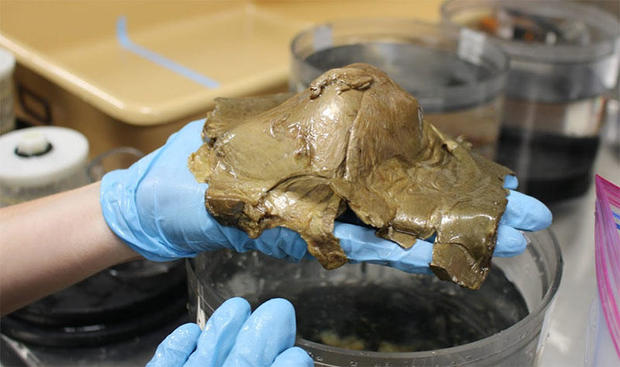Mysterious "golden egg" found 2 miles deep on ocean floor off Alaska — and scientists still don't know what it is
A golden egg, or an alien, on the bottom of the Pacific Ocean?
American scientists have discovered a mysterious dome-shaped specimen deep on the Alaskan seafloor, but nobody knows for sure what it is.
Ocean researchers using a remotely operated survey vehicle were amazed last week when they spotted the strange item on a rock about two miles deep in the Gulf of Alaska.
One of the videographers onboard helping to document the dive referred to the item as a "yellow hat," the National Oceanic and Atmospheric Administration said in a statement.
It is over 4 inches in diameter and has a small tear near its base.
"As cameras zoomed in, scientists were stumped as to its identification, with initial thoughts ranging from a dead sponge attachment, to coral, to an egg casing," NOAA said.
"Invoking almost fairytale-like imagery, the specimen has since been dubbed a 'golden orb' and even a 'golden egg,'" the agency added.
"Isn't the deep sea so delightfully strange?" wondered Sam Candio, a NOAA Ocean Exploration coordinator.
As theories swirled on social media, including that of it being an alien egg, scientists extracted their Aug. 30 discovery from the ocean floor to analyze it in a laboratory setting.
"While we were able to collect the 'golden orb' and bring it onto the ship, we still are not able to identify it beyond the fact that it is biological in origin," NOAA said.
It remains unclear if the golden dome is associated with a known species, a new species, or represents an unknown life stage of an existing one, according to Candio.
"New species have the potential to reveal new sources for medical therapies and vaccines, food, energy, and other societal benefits and knowledge," Candio said. "Collectively, the data and information gathered during this expedition will help us close gaps in our understanding of this part of the planet, so we can better manage and protect it."
While researchers hope the discovery will provide new information, they still don't know what the "golden egg" is.
"While somewhat humbling to be stumped by this finding, it serves as a reminder of how little we know about our own planet and how much is left to learn and appreciate about our ocean," Candio added.
Jon Copley, a professor of ocean exploration and science communication at the University of Southampton, echoed Candio's sentiment.
"We often find things in the deep ocean that we haven't seen before or don't immediately recognize, because the deep ocean is vast and we've only been exploring what lives there over the past couple of centuries, unlike life on land," Copley told The Washington Post.
The dive was part of an expedition in the Gulf of Alaska to explore deepwater habitats.
NOAA said the expedition will continues through Sept. 16, with livestreamed, remotely operated vehicle dives happening daily.





